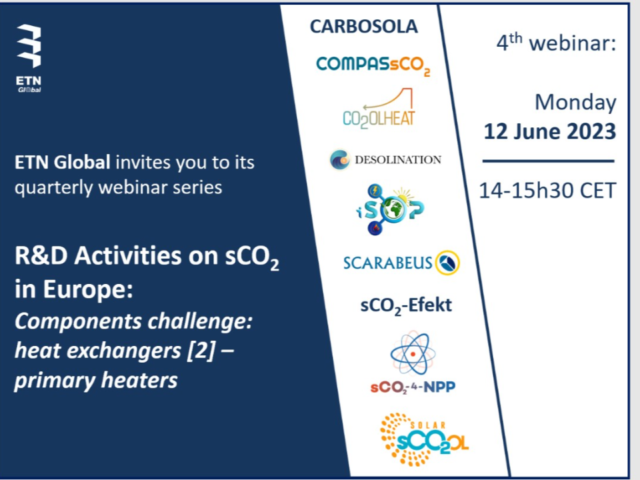


Dear visitor,
SOLARSCO2OL is thrilled to announce that the project activities have resumed since February 2023!
The intensive efforts of our Task Force paid off in overcoming the challenging conditions that led to the temporary suspension of project activities.
Please check our website regularly and follow our social media channels for project news and updates.
The SOLARSCO2OL Project Consortium
about the project
SOLARSCO2OL is an EU H2020 funded project aiming at developing an innovative, economically viable and easily replicable supercritical CO2 (sCO2) power block for demonstrating the use of sCO2 cycles as a potential key technology to increase the flexibility of concentrated solar power (CSP) plants. This will reduce their Levelised Cost of Electricity (LCOE) to values below 10 c€/kWh in Europe and promote an innovative power plant cycle layout not requiring water.
The innovative SOLARSCO2OL plant layout, coupled with fast-reactive electric heaters and efficient heat exchangers (HEXs), will enable the operation and design of novel integrated CSP plant layouts.
key objectives
Flexibility & Efficiency
Increase the operational flexibility and efficiency of existing and future CSP plants by using sCO2 power cycles able to be operated at temperature levels achievable by state-of-the-art concentrators, thereby also eliminating the use of water in the power cycle.
Cost-Competitiveness
Use novel sCO2 plant designs for generating solar thermal electricity in a more cost-competitive way
Sustainability
Help unlock the potential of CSP in Europe and worldwide to reach decarbonisation targets.
WHY sCO2?
Making next-generation CSP plants more cost-competitive
sCO2 power cycles can perfectly operate CSP current temperatures, producing power with higher efficiency if compared with Rankine cycles traditionally used in CSP plants and without using water as operating fluid. sCO2 power cycles have a large room for cost reduction and also considering their reduced required volume/size footprint.
In this sense, as heat exchangers can comprise up to 60%−70% of the total cost of a CSP sCO2 power cycle, a relevant attention has to be put on this topic. So, a new design with fast-reactive electric heaters (that would also enable PV hybridization of the CSP plant) and efficient heat exchangers (HEXs), can help sCO2-CSP plants become more cost-competitive.
Project concept
PV FIELD
In this scheme the photovoltaic (PV) field is included. Actually, it is OPTIONAL, the idea is that the electricity in excess produced by the PV plant can be used in the electric heater (See ELECTRIC HEATER) for further explanation.
MOLTEN SALT ELECTRIC HEATER
The molten salt electrical heater uses electricity to heat the molten salts. In times, when there is not enough direct radiation for CSP available or the increasing share of photovoltaic (PV) and wind energy leads to excess power in the grid, the electric molten salt heater is employed to heat the molten salts with PV or wind electricity.
This avoids curtailment of renewable power systems and enables a further increase of PV and wind capacity. In this way, the system can act in a controlled manner both as power supply as well as power sink, and thus contribute to grid balancing with positive and negative power. The connection from grid to electric heater is optional.
CONCENTRATING SOLAR POWER (CSP)
Concentrating Solar Power (CSP) systems use mirrors to focus sunlight on a small spot, where an absorber medium gets heated. The absorbed heat can be directly used to generate electricity, or stored for later use.
FLOW LEGEND
Yellow flows: ELECTRICITY
Red flows: MOLTEN SALTS flowing into component
Blu flows: sCO2 flowing into component(For the fluids: darker the color, higher the temperature)
SOLAR FIELD - HELIOSTATS
Heliostats are movable mirrors, which reflect sunlight to the top of the tower. Computers control the heliostats to ensure their proper and correct alignment according to the movement of the sun during the day.
Receiver
The receiver is the component where the sunlight is concentrated. In this case a Molten Salt Receiver is utilized. Molten Salts flow into the receiver and are heated by the incoming solar radiation.
STORAGE
The energy storage is the component where thermal energy (heat) is stored for later use, allowing the generation of dispatchable power. Specifically, the heated molten salts are directly stored in an insulated tank (HOT TANK). After passing the Molten Salt / sCO2 Heat Exchanger, the cooled molten salts are stored in a second tank (COLD TANK).
HEAT EXCHANGER
The heat exchanger is the component where the heat is transferred from the molten salt to the supercritical CO2 (sCO2). The molten salts becomes colder while the sCO2 becomes hotter.
sCO2 POWER BLOCK
The power block is the 'block' where the thermal energy (heat) is converted into electricity (yellow flow). The high-pressure sCO2, heated up in the Molten Salt / sCO2 Heat Exchanger, expands in the sCO2 turbine, producing mechanical energy. Part of this energy is used to run the sCO2 compressor, while the rest is converted in electricity using the generator (yellow box).
The Recuperator is utilized to recover the heat from sCO2 that comes out from the turbine. The cooler is used to extract heat from the sCO2 (ejected heat) in order to reduce the cold sCO2 temperature, which increases.
The sCO2 density at the inlet to the compressor and reduces its specific power requirement.
PLANT OPERATION AT NIGHT
During the night:
The molten salts stored during the day from the hot tank flow to the Molten Salt / sCO2 Heat Exchanger, heat and run the sCO2 power block and thus produce electricity (to the grid) at night.
Scenario 1: The CSP plant produces only electricity (while the storage is discharging)
Scenario 2: Optionally, the excess of electricity in the grid can be used in the electric heater to heat the Molten Salt and store them in the Hot Tank. The CSP plant can produce electricity and also produce heat to be used later.
THERMAL ENERGY
Heated molten salts flow into the Hot Tank: store part of the molten salts into the Hot Tank, use the rest to heat the sCO2 in the Molten Salt / sCO2 Heat Exchanger.
PRODUCING POWER
Run the power block and produce electricity (to the grid)
Twitter feed is not available at the moment.




















